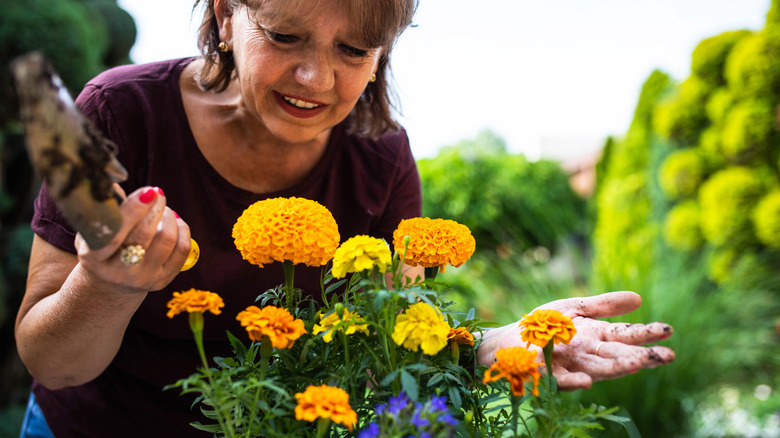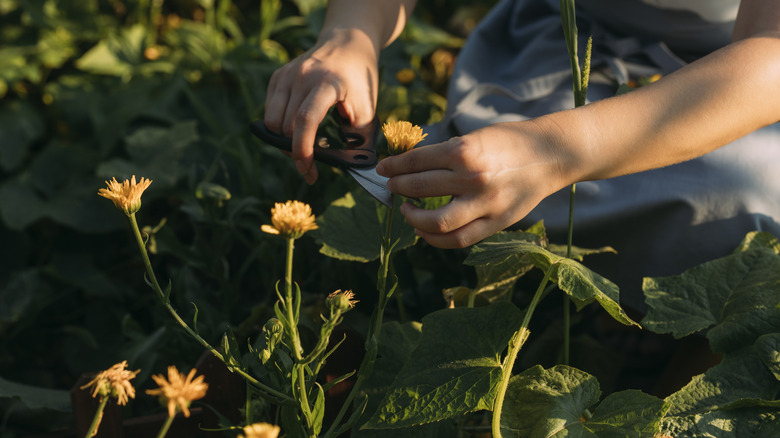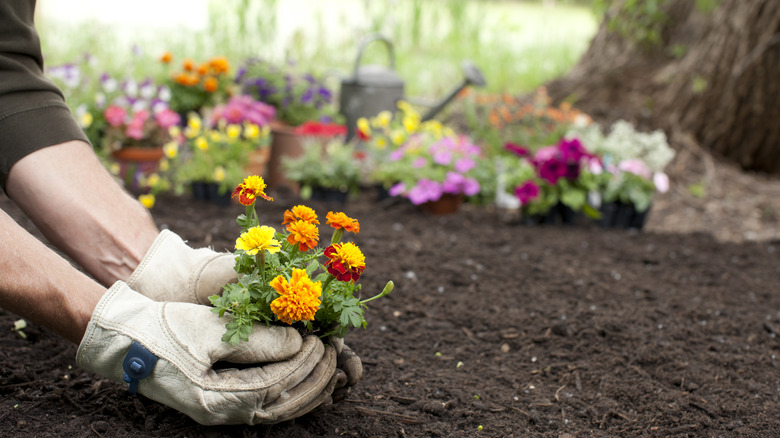The Common Mistake You Might Be Making With Your Marigolds
Marigolds (or tagetes) are a popular garden staple for several reasons. Their vibrant hues and robust blooms can brighten up any garden space, and they're also known for their resilience and ability to thrive in various conditions. Marigolds are not only aesthetically pleasing but also offer a natural way to repel bugs, acting as an eco-friendly deterrent against pests such as mosquitoes and nematodes, and attracting beneficial bugs like ladybugs, parasitic wasps, and hover flies. Gardeners often invest time in providing the ideal soil, sunlight, and water conditions for these resilient flowers. However, amidst giving marigolds meticulous care, one crucial practice is often overlooked — deadheading.
Deadheading involves the removal of spent or faded flowers. It's a practice that plays a pivotal role in enhancing the overall health and vitality of marigold plants. So, even if you've been carefully tending to the needs of the marigolds in your garden, neglecting this simple yet crucial task can hinder the full potential of your plants.
The importance of deadheading
The science behind deadheading marigolds lies in the principles of plant physiology and reproductive biology. The primary purpose of a flowering plant is to produce seeds for reproduction. When a marigold flower begins to fade, the plant directs energy towards seed development. However, by removing the spent flowers, gardeners interrupt this natural process. The plant then redirects its energy away from seed production, focusing instead on the growth of new buds, promoting prolonged blooming and a more abundant display of flowers.
Another function of deadheading is auxin regulation. Auxins are plant hormones that play a crucial role in various aspects of growth and development, including apical dominance. Apical dominance is the tendency of a plant to concentrate its growth at the apex, or tip, of the main stem. When you deadhead a marigold flower, you alter the auxin balance. This disruption releases lateral buds from the inhibitory effect of apical dominance, encouraging the growth of side shoots and additional flower buds.
Deadheading can also help you maintain a tidy garden. Faded or wilted flowers can detract from the overall beauty of your landscape or yard. By regularly removing spent marigold blooms, you create a cleaner and more polished look. Your meticulous care will reflect positively on your garden's aesthetic appeal. Also, the removal of spent flowers contributes to the prevention of diseases. Decaying or dead plant material can create a hospitable environment for pathogens, so deadheading eliminates potential breeding grounds for diseases.
Proper deadheading and care for marigolds
Deadheading marigolds is a straightforward yet essential task that can significantly impact the plant's growth. To deadhead effectively, wait until the blooms begin to fade, then pinch or cut the spent flowers just above the first set of leaves. Alternatively, consider using clean and sanitized scissors or pruning shears for deadheading larger marigold varieties. Regular deadheading throughout the growing season stimulates continuous flowering so you'll have marigold blooms to enjoy for longer. Remember to dispose of the removed flowers to prevent potential disease.
Beyond deadheading, maintaining a flourishing marigold garden involves attention to various factors. Provide well-draining soil, ensuring adequate moisture without waterlogging. Marigolds thrive in full sunlight, so choose a location with at least six hours of direct sunlight per day. Marigolds don't typically require fertilizing after their initial planting unless the soil is deficient. Monitor pests like aphids, slugs, snails, caterpillars, and powdery mildew diligently, and employ garden hygiene and natural remedies to eliminate them. By integrating these practices, you can ensure a continuous display of marigold blooms and a healthy, flourishing garden.


